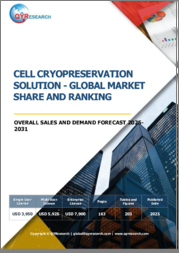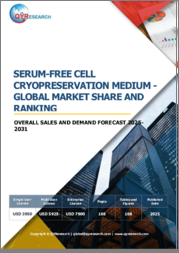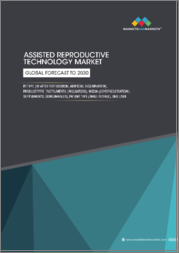
|
시장보고서
상품코드
1376036
세포 동결보존 시장 규모, 점유율, 동향 분석 보고서 : 제품별, 용도별, 최종 용도별, 지역별, 부문별 예측(2024-2030년)Cell Cryopreservation Market Size, Share & Trends Analysis Report By Product (Cell Freezing Media, Equipment), By Application (Stem Cells, Sperm Cells), By End-use (Biobanks, IVF), By Region, And Segment Forecasts, 2024 - 2030 |
||||||
세포 동결보존 시장 성장과 동향:
Grand View Research, Inc.의 최신 보고서에 따르면 세계 세포 동결보존 시장 규모는 2030년까지 350억 3,000만 달러에 달하고 CAGR은 21.01%에 달할 것으로 예상됩니다.
불임률의 증가와 함께 즉시 냉동 가능한 배지의 사용이 증가함에 따라 이러한 제품에 대한 수요가 증가하고 있습니다. 또한, 만성 질환의 유병률 증가와 질병 관리에서 세포 치료의 중요성이 증가함에 따라 효과적인 냉동 보존에 대한 수요가 증가하고 있습니다.
비용 효율적인 동결보존 배지에 대한 수요 증가는 첨단 의약품 개발을 위한 연구개발(R&D) 활동의 증가에 기인합니다. 살아있는 세포를 냉동 보존할 때 빙정 발생을 억제할 수 있는 즉시 사용 가능한 배지는 연구 커뮤니티에서 점점 더 많이 채택되고 있습니다. 또한, 세포 기반 의약품의 인기가 높아짐에 따라 제조업체들이 심각한 질병을 치료할 수 있는 첨단 바이오의약품을 개발하기 위해 대규모 투자를 하고 있으며, 이는 냉동 보존에 대한 수요를 촉진하고 시장 성장을 더욱 촉진할 것으로 보입니다.
COVID-19 백신의 급속한 연구개발과 상업적 제조 활동의 지속은 생물학적 제제 기반 연구 활동에 큰 영향을 미치고 자극을 주어 시장 성장에 기여하고 있습니다. 또한, 시장 수요의 증가, 경쟁사 간의 경쟁 심화, 최종사용자의 다양한 용도는 모두 냉동 보존용 동결 배지의 처방 개발에 기여하고 있으며, 현재 맞춤형으로 사용할 수 있게 되었습니다. 예를 들어, Merck KGaA의 시그마 알드리치(Sigma Aldrich) 브랜드는 최적의 회수 및 세포 생존을 보장하는 줄기세포용 냉동배지 솔루션을 제공하고 있습니다.
이러한 냉동 매체는 기존 냉동 공정보다 다재다능하고, 즉시 사용할 수 있고, 저렴하기 때문에 최종사용자들 사이에서 널리 채택되고 있습니다. 기존의 냉동 공정은 액체 질소를 사용해야 하기 때문에 안전에 대한 우려가 큽니다. 질소 사용의 다른 단점으로는 2차 오염 가능성, 높은 운영 비용, 대기 중 산소 대체에 따른 질식 위험 등이 있습니다. 그 결과 최근 몇 년 동안 즉시 사용 가능한 냉동 매체의 사용이 증가하여 냉동 보존 시장을 더욱 촉진하고 있습니다.
또한, 냉동배지 제제 및 냉동보존 기술 연구개발, 조직공학, 세포치료, 줄기세포 연구 등의 분야에서 냉동보존 냉동배지 응용분야의 활용이 시장을 크게 견인하고 있습니다. 재생의료 및 세포 기반 연구에 대한 정부의 우호적인 규제는 세계 시장을 더욱 촉진할 것으로 예상됩니다.
세포 동결보존 시장 보고서 하이라이트
- 제품별로는 소모품 부문이 2023년 40.76%의 가장 큰 시장 점유율을 차지했습니다. 이 시장은 세포 기반 치료 및 보존에 대한 수요 증가와 최종사용자의 소모품 재구매로 인해 확대되고 있습니다.
- 용도별로는 줄기세포가 2023년 35.80%로 가장 큰 시장 점유율을 차지했습니다. 의료진과 과학자들의 줄기세포 연구 증가와 첨단 치료법 개발이 시장 성장의 원동력이 될 것으로 예상됩니다.
- 북미 지역은 2023년 40.26%의 가장 큰 시장 점유율을 차지했습니다. 이는 주로 주요 시장 진입자의 존재와 이 지역의 의료 비용 상승에 기인합니다.
목차
제1장 조사 방법과 범위
제2장 주요 요약
제3장 시장 변수, 동향 및 범위
- 시장 계통 전망
- 상부 시장 전망
- 관련/부수 시장 전망
- 시장 동향과 전망
- 시장 역학
- 난자 동결 주기 증가
- 줄기세포 연구개발 활동 증가
- 바이오뱅크 수 증가와 맞춤형 의료 수요 급증
- 시장 성장 억제요인 분석
- 높은 설비비
- 사업 환경 분석
- PESTEL 분석
- Porter's Five Forces 분석
- COVID-19 감염증의 영향 분석
제4장 제품 비지니스 분석
- 세계의 세포 동결보존 시장 : 제품 변동 분석
- 세포 동결 배지
- 세포 동결 배지 시장, 2018-2030년
- 에틸렌글리콜
- 디메틸술폭시드
- 글리세롤
- 기타
- 장비
- 기기 시장, 2018-2030년
- 냉동고
- 보육기
- 액체 질소 공급 탱크
- 소모품
- 소모품 시장, 2018-2030년
- 극저온 바이알
- 극저온 튜브
- 쿨러 박스·컨테이너
- 기타
제5장 용도 비지니스 분석
- 세계의 세포 동결보존 시장 : 용도 변동 분석
- 줄기세포
- 난모세포와 배세포
- 정자세포
- 간세포
- 기타
제6장 최종 용도 비지니스 분석
- 세계의 세포 동결보존 시장 : 최종 용도 변동 분석
- 바이오의약품 및 제약회사
- 바이오의약품 및 제약회사 시장, 2018-2030년
- 조사기관
- 조사기관 시장, 2018-2030년
- 바이오뱅크
- 바이오뱅크 시장, 2018-2030년
- 체외수정 클리닉
- 체외수정 클리닉 시장, 2018-2030년
- 기타
- 기타 시장, 2018-2030년
제7장 지역 비지니스 분석
- 세계의 세포 동결보존 시장 점유율(지역별, 2023년 및 2030년)
- 북미
- 유럽
- 아시아태평양
- 라틴아메리카
- 중동 및 아프리카
제8장 경쟁 상황
- 기업 분류
- 전략 매핑
- 기업 시장 점유율/포지션 점유율 분석, 2023년
- 기업 개요·리스트
- Thermo Fisher Scientific Inc.
- PromoCell GmbH
- Merck KGaA
- Sartorius AG
- Lonza
- Corning Incorporated
- Creative Biolabs
- BioLife Solutions Inc.
- Danaher
- HiMedia Laboratories
Cell Cryopreservation Market Growth & Trends:
The global cell cryopreservation market size is expected to reach USD 35.03 billion by 2030 with a CAGR of 21.01%, according to a new report by Grand View Research, Inc.. The increased use of ready-to-freeze media, combined with rising infertility rates, is driving demand for these products. Furthermore, the rising prevalence of chronic diseases, as well as the increasing importance of cell therapy for disease management, have prompted the demand for effective cryopreservation.
The increased demand for cost-effective cryopreservation medium has stemmed from increased research & development (R&D) activities to create advanced medicines. The capacity of ready-to-use media to decrease the development of ice crystals while cryopreserving live cells led to its increasing adoption among the research community. Furthermore, the rising popularity of cell-based drugs has resulted in massive investments from manufacturers to develop sophisticated biopharmaceuticals for serious medical conditions, which will propel the demand for cryopreservation and further boost the market growth.
The rapid R&D for the COVID-19 vaccine, as well as its continued commercial manufacturing activities, have also significantly impacted and stimulated biologics-based research activities, resulting in increased market growth. Furthermore, the growing market demand, increased competition among competitors, and diverse applications by end-users have all contributed to developments in cryopreservation freezing media formulations, which are now even accessible on a custom basis. For example, Merck KGaA's Sigma Aldrich brand provides frozen media solutions for stem cell applications while ensuring optimal recovery and cell survival, thus, propelling the cryopreservation market growth.
The versatility, ready-to-use, and inexpensive cost of these media over traditional freezing processes have resulted in widespread adoption among end-users. Traditional freezing processes necessitate the use of liquid nitrogen, which has significant safety concerns. Other disadvantages of nitrogen use include the potential of cross-contamination, high operating costs, and the risk of asphyxiation due to the displacement of atmospheric oxygen. As a result, the use of ready-to-use freezing media has grown in recent years which further boosts the cryopreservation market.
Additionally, developments in freezing media formulation and cryopreservation techniques, as well as leveraging cryopreservation freezing media applications in fields such as tissue engineering, cellular treatment, and stem cell research, have driven the market at a substantial rate. Favorable government regulations for regenerative medicine & cell-based research are expected to further boost the global market.
Cell Cryopreservation Market Report Highlights:
- Based on product, the consumables segment accounted for the largest market share of 40.76% in 2023. The market is expanding due to the growing demand for cell based-therapies & preservation, and re-purchasing of consumables by end-users
- Based on application, stem cells accounted for the largest market share of 35.80% in 2023. Increased stem cell research and the development of advanced therapies by medical professionals and scientists is predicted to drive the market growth
- North America held the largest market share of 40.26% in 2023. This is mostly due to the presence of major market participants and the rising cost of healthcare in the region
Table of Contents
Chapter 1. Methodology and Scope
- 1.1. Market Segmentation and Scope
- 1.2. Market Definitions
- 1.2.1. Product Segment
- 1.2.2. Application Segment
- 1.2.3. End-user Segment
- 1.3. Information analysis
- 1.4. Market formulation & data visualization
- 1.5. Data validation & publishing
- 1.6. Information Procurement
- 1.6.1. Primary Research
- 1.7. Information or Data Analysis
- 1.8. Market Formulation & Validation
- 1.9. Market Model
- 1.10. Objectives
Chapter 2. Executive Summary
- 2.1. Market Outlook
- 2.2. Segment Snapshot
- 2.3. Competitive Landscape Snapshot
Chapter 3. Market Variables, Trends, & Scope
- 3.1. Market Lineage Outlook
- 3.1.1. Parent Market Outlook
- 3.1.2. Related/Ancillary Market Outlook
- 3.2. Market Trends and Outlook
- 3.3. Market Dynamics
- 3.3.1. Increase in the number of egg-freezing cycles
- 3.3.2. Increase in research and development activities for stem cells
- 3.3.3. Rise in the number of biobanks and surge in demand for personalized medicines
- 3.4. Market Restraint Analysis
- 3.4.1. High cost of equipment
- 3.5. Business Environment Analysis
- 3.5.1. PESTEL Analysis
- 3.5.2. Porter's Five Forces Analysis
- 3.5.3. COVID-19 Impact Analysis
Chapter 4. Product Business Analysis
- 4.1. Global Cell Cryopreservation Market: Product Movement Analysis
- 4.2. Cell Freezing Media
- 4.2.1. Cell Freezing Media Market, 2018 - 2030 (USD Million)
- 4.2.2. Ethylene Glycol
- 4.2.2.1. Ethylene Glycol Market, 2018 - 2030 (USD Million)
- 4.2.3. Dimethyl Sulfoxide
- 4.2.3.1. Dimethyl Sulfoxide Market, 2018 - 2030 (USD Million)
- 4.2.4. Glycerol
- 4.2.4.1. Glycerol Market, 2018 - 2030 (USD Million)
- 4.2.5. Others
- 4.2.5.1. Others Market, 2018 - 2030 (USD Million)
- 4.3. Equipment
- 4.3.1. Equipment Market, 2018 - 2030 (USD Million)
- 4.3.2. Freezers
- 4.3.2.1. Freezers Market, 2018 - 2030 (USD Million)
- 4.3.3. Incubators
- 4.3.3.1. Incubators Market, 2018 - 2030 (USD Million)
- 4.3.4. Liquid Nitrogen Supply Tanks
- 4.3.4.1. Liquid Nitrogen Supply Tanks Market, 2018 - 2030 (USD Million)
- 4.4. Consumables
- 4.4.1. Consumables Market, 2018 - 2030 (USD Million)
- 4.4.2. Cryogenic vials
- 4.4.2.1. Cryogenic Vials Market, 2018 - 2030 (USD Million)
- 4.4.3. Cryogenic tubes
- 4.4.3.1. Cryogenic Tubes Market, 2018 - 2030 (USD Million)
- 4.4.4. Cooler boxes/containers
- 4.4.4.1. Cooler boxes/containers Market, 2018 - 2030 (USD Million)
- 4.4.5. Others
- 4.4.5.1. Others Market, 2018 - 2030 (USD Million)
Chapter 5. Application Business Analysis
- 5.1. Global Cell Cryopreservation Market: Application Movement Analysis
- 5.2. Stem Cells
- 5.2.1. Stem Cells Market, 2018 - 2030 (USD Million)
- 5.3. Oocytes and Embryotic cells
- 5.3.1. Oocytes and Embryotic Cells Market, 2018 - 2030 (USD Million)
- 5.4. Sperm Cells
- 5.4.1. Sperm Cells Market, 2018 - 2030 (USD Million)
- 5.5. Hepatocytes
- 5.5.1. Hepatocytes Market, 2018 - 2030 (USD Million)
- 5.6. Others
- 5.6.1. Others Market, 2018 - 2030 (USD Million)
Chapter 6. End-Use Business Analysis
- 6.1. Global Cell Cryopreservation Market: End-Use Movement Analysis
- 6.2. Biopharmaceutical & Pharmaceutical Companies
- 6.2.1. Biopharmaceutical & Pharmaceutical Companies Market, 2018 - 2030 (USD Million)
- 6.3. Research Institutes
- 6.3.1. Research Institutes Market, 2018 - 2030 (USD Million)
- 6.4. Biobanks
- 6.4.1. Biobanks Market, 2018 - 2030 (USD Million)
- 6.5. IVF clinics
- 6.5.1. IVF Clinics Market, 2018 - 2030 (USD Million)
- 6.6. Others
- 6.6.1. Others Market, 2018 - 2030 (USD Million)
Chapter 7. Regional Business Analysis
- 7.1. Global Cell Cryopreservation Market Share By Region, 2023 & 2030
- 7.2. North America
- 7.2.1. North America Cell Cryopreservation Market, 2018 - 2030 (USD Million)
- 7.2.2. U.S.
- 7.2.2.1. Key Country Dynamics
- 7.2.2.2. Competitive Scenario
- 7.2.2.3. Target Disease Prevalence
- 7.2.2.4. U.S. Cell Cryopreservation Market, 2018 - 2030 (USD Million)
- 7.2.3. Canada
- 7.2.3.1. Key Country Dynamics
- 7.2.3.2. Competitive Scenario
- 7.2.3.3. Target Disease Prevalence
- 7.2.3.4. Canada Cell Cryopreservation Market, 2018 - 2030 (USD Million)
- 7.3. Europe
- 7.3.1. Europe Cell Cryopreservation Market, 2018 - 2030 (USD Million)
- 7.3.2. Germany
- 7.3.2.1. Key Country Dynamics
- 7.3.2.2. Competitive Scenario
- 7.3.2.3. Target Disease Prevalence
- 7.3.2.4. Germany Cell Cryopreservation Market, 2018 - 2030 (USD Million)
- 7.3.3. UK
- 7.3.3.1. Key Country Dynamics
- 7.3.3.2. Competitive Scenario
- 7.3.3.3. Target Disease Prevalence
- 7.3.3.4. UK Cell Cryopreservation Market, 2018 - 2030 (USD Million)
- 7.3.4. France
- 7.3.4.1. Key Country Dynamics
- 7.3.4.2. Competitive Scenario
- 7.3.4.3. Target Disease Prevalence
- 7.3.4.4. France Cell Cryopreservation Market, 2018 - 2030 (USD Million)
- 7.3.5. Italy
- 7.3.5.1. Key Country Dynamics
- 7.3.5.2. Competitive Scenario
- 7.3.5.3. Target Disease Prevalence
- 7.3.5.4. Italy Cell Cryopreservation Market, 2018 - 2030 (USD Million)
- 7.3.6. Spain
- 7.3.6.1. Key Country Dynamics
- 7.3.6.2. Competitive Scenario
- 7.3.6.3. Target Disease Prevalence
- 7.3.6.4. Spain Cell Cryopreservation Market, 2018 - 2030 (USD Million)
- 7.3.7. Denmark
- 7.3.7.1. Key Country Dynamics
- 7.3.7.2. Competitive Scenario
- 7.3.7.3. Target Disease Prevalence
- 7.3.7.4. Denmark Cell Cryopreservation Market, 2018 - 2030 (USD Million)
- 7.3.8. Sweden
- 7.3.8.1. Key Country Dynamics
- 7.3.8.2. Competitive Scenario
- 7.3.8.3. Target Disease Prevalence
- 7.3.8.4. Sweden Cell Cryopreservation Market, 2018 - 2030 (USD Million)
- 7.3.9. Norway
- 7.3.9.1. Key Country Dynamics
- 7.3.9.2. Competitive Scenario
- 7.3.9.3. Target Disease Prevalence
- 7.3.9.4. Norway Cell Cryopreservation Market, 2018 - 2030 (USD Million)
- 7.4. Asia Pacific
- 7.4.1. Asia Pacific Cell Cryopreservation Market, 2018 - 2030 (USD Million)
- 7.4.2. Japan
- 7.4.2.1. Key Country Dynamics
- 7.4.2.2. Competitive Scenario
- 7.4.2.3. Target Disease Prevalence
- 7.4.2.4. Japan Cell Cryopreservation Market, 2018 - 2030 (USD Million)
- 7.4.3. China
- 7.4.3.1. Key Country Dynamics
- 7.4.3.2. Competitive Scenario
- 7.4.3.3. Target Disease Prevalence
- 7.4.3.4. China Cell Cryopreservation Market, 2018 - 2030 (USD Million)
- 7.4.4. India
- 7.4.4.1. Key Country Dynamics
- 7.4.4.2. Competitive Scenario
- 7.4.4.3. Target Disease Prevalence
- 7.4.4.4. India Cell Cryopreservation Market, 2018 - 2030 (USD Million)
- 7.4.5. South Korea
- 7.4.5.1. Key Country Dynamics
- 7.4.5.2. Competitive Scenario
- 7.4.5.3. Target Disease Prevalence
- 7.4.5.4. South Korea Cell Cryopreservation Market, 2018 - 2030 (USD Million)
- 7.4.6. Australia
- 7.4.6.1. Key Country Dynamics
- 7.4.6.2. Competitive Scenario
- 7.4.6.3. Target Disease Prevalence
- 7.4.6.4. Australia Cell Cryopreservation Market, 2018 - 2030 (USD Million)
- 7.4.7. Thailand
- 7.4.7.1. Key Country Dynamics
- 7.4.7.2. Competitive Scenario
- 7.4.7.3. Target Disease Prevalence
- 7.4.7.4. Thailand Cell Cryopreservation Market, 2018 - 2030 (USD Million)
- 7.5. Latin America
- 7.5.1. Latin America Cell Cryopreservation Market, 2018 - 2030 (USD Million)
- 7.5.2. Brazil
- 7.5.2.1. Key Country Dynamics
- 7.5.2.2. Competitive Scenario
- 7.5.2.3. Target Disease Prevalence
- 7.5.2.4. Brazil Cell Cryopreservation Market, 2018 - 2030 (USD Million)
- 7.5.3. Mexico
- 7.5.3.1. Key Country Dynamics
- 7.5.3.2. Competitive Scenario
- 7.5.3.3. Target Disease Prevalence
- 7.5.3.4. Mexico Cell Cryopreservation Market, 2018 - 2030 (USD Million)
- 7.5.4. Argentina
- 7.5.4.1. Key Country Dynamics
- 7.5.4.2. Competitive Scenario
- 7.5.4.3. Target Disease Prevalence
- 7.5.4.4. Argentina Cell Cryopreservation Market, 2018 - 2030 (USD Million)
- 7.6. MEA
- 7.6.1. MEA Cell Cryopreservation Market, 2018 - 2030 (USD Million)
- 7.6.2. South Africa
- 7.6.2.1. Key Country Dynamics
- 7.6.2.2. Competitive Scenario
- 7.6.2.3. Target Disease Prevalence
- 7.6.2.4. South Africa Cell Cryopreservation Market, 2018 - 2030 (USD Million)
- 7.6.3. Saudi Arabia
- 7.6.3.1. Key Country Dynamics
- 7.6.3.2. Competitive Scenario
- 7.6.3.3. Target Disease Prevalence
- 7.6.3.4. Saudi Arabia Cell Cryopreservation Market, 2018 - 2030 (USD Million)
- 7.6.4. UAE
- 7.6.4.1. Key Country Dynamics
- 7.6.4.2. Competitive Scenario
- 7.6.4.3. Target Disease Prevalence
- 7.6.4.4. UAE Cell Cryopreservation Market, 2018 - 2030 (USD Million)
- 7.6.5. Kuwait
- 7.6.5.1. Key Country Dynamics
- 7.6.5.2. Competitive Scenario
- 7.6.5.3. Target Disease Prevalence
- 7.6.5.4. Kuwait Cell Cryopreservation Market, 2018 - 2030 (USD Million)
Chapter 8. Competitive Landscape
- 8.1. Company Categorization
- 8.2. Strategy Mapping
- 8.3. Company Market/Position Share Analysis, 2023
- 8.4. Company Profiles/Listing
- 8.4.1. Thermo Fisher Scientific Inc.
- 8.4.1.1. Overview
- 8.4.1.2. Financial Performance (Net Revenue/Sales/EBITDA/Gross Profit)
- 8.4.1.3. Product Benchmarking
- 8.4.1.4. Strategic Initiatives
- 8.4.2. PromoCell GmbH
- 8.4.2.1. Overview
- 8.4.2.2. Product Benchmarking
- 8.4.2.3. Strategic Initiatives
- 8.4.3. Merck KGaA
- 8.4.3.1. Overview
- 8.4.3.2. Financial Performance (Net Revenue/Sales/EBITDA/Gross Profit)
- 8.4.3.3. Product Benchmarking
- 8.4.3.4. Strategic Initiatives
- 8.4.4. Sartorius AG
- 8.4.4.1. Overview
- 8.4.4.2. Financial Performance (Net Revenue/Sales/EBITDA/Gross Profit)
- 8.4.4.3. Product Benchmarking
- 8.4.4.4. Strategic Initiatives
- 8.4.5. Lonza
- 8.4.5.1. Overview
- 8.4.5.2. Financial Performance (Net Revenue/Sales/EBITDA/Gross Profit)
- 8.4.5.3. Product Benchmarking
- 8.4.5.4. Strategic Initiatives
- 8.4.6. Corning Incorporated
- 8.4.6.1. Overview
- 8.4.6.2. Financial Performance (Net Revenue/Sales/EBITDA/Gross Profit)
- 8.4.6.3. Product Benchmarking
- 8.4.6.4. Strategic Initiatives
- 8.4.7. Creative Biolabs
- 8.4.7.1. Overview
- 8.4.7.2. Product Benchmarking
- 8.4.7.3. Strategic Initiatives
- 8.4.8. BioLife Solutions Inc.
- 8.4.8.1. Overview
- 8.4.8.2. Financial Performance (Net Revenue/Sales/EBITDA/Gross Profit)
- 8.4.8.3. Product Benchmarking
- 8.4.8.4. Strategic Initiatives
- 8.4.9. Danaher
- 8.4.9.1. Overview
- 8.4.9.2. Financial Performance (Net Revenue/Sales/EBITDA/Gross Profit)
- 8.4.9.3. Product Benchmarking
- 8.4.9.4. Strategic Initiatives
- 8.4.10. HiMedia Laboratories
- 8.4.10.1. Overview
- 8.4.10.2. Product Benchmarking
- 8.4.10.3. Strategic Initiatives
- 8.4.1. Thermo Fisher Scientific Inc.
(주말 및 공휴일 제외)


















